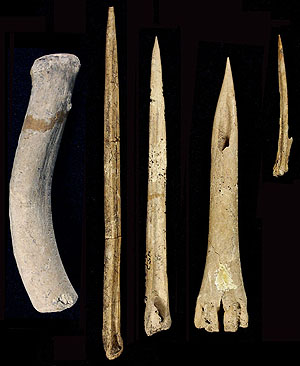Small-brained human ancestors used stone tools to whack into large mammals some 800,000 years earlier than previously thought.

THE GIST
- The earliest known evidence for stone tool use and meat eating among early humans is found.
- The evidence -- butchered, fossilized bones -- dates to roughly 3.4 million years ago.
- It's believed the ancestor Australopithecus afarensis (to which "Lucy" belongs) used the tools.
Fossilized bones scarred by hack marks reveal that our human ancestors were using stone tools and eating meat from large mammals nearly a million years earlier than previously thought, according to a new study that pushes back both of these human activities to roughly 3.4 million years ago.
The first known human ancestor tool wielder and meat lover was Australopithecus afarensis, according to the study, published in the latest issue of Nature. This species, whose most famous representative is the skeleton "Lucy," was slender, toothy and small-brained.
"By pushing the date for tool use and meat eating in our lineage back by around 1 million years, our finds show that tool use and meat eating was not unique to (the genus) Homo, a widely accepted notion in our field," co-author Zeresenay Alemseged told Discovery News.
"Also, by showing that A. afarensis was involved in these activities, we showed that you do not need a large brain to do this," added Alemseged, director of the Department of Anthropology at the California Academy of Sciences.
"This is a kind of find that will force us to revise our human evolution and anthropology textbooks."
See what the faces of our early ancestors looked like.
He and his colleagues from the Dikika Research Project made the determinations while working in the Afar Region of Ethiopia. There they unearthed two fossilized bones bearing stone tool marks. One of the bones belonged to a large, buffalo-sized, hoofed mammal, while the other was possibly from an Impala, gazelle or antelope.
Various types of electron microscopy, along with chemical analysis, determined that cut marks were inflicted while one or more individuals carved meat off the bones with a sharp stone tool. Percussion marks were also created when a stone tool broke open the bones to extract their nutritious marrow.
The fossilized bones were found sandwiched between volcanic deposits, which permitted reliable dating of them. Before this discovery, the world's oldest human evidence for butchery dated to 2.5 million years ago and came from Bouri and Gona, Ethiopia. No human remains were found in association with those fossilized prey bones, but A. afarensis remains were previously unearthed near the recent Afar Region discoveries.
Since the Afar stone tools were transported to the kill or scavenge site from nearly four miles away, A. afarensis must have valued the sharp objects. What's unclear, however, is whether or not the ancient hominids made the stones themselves, or just picked already sharp stones up from the ground.
Lead author Shannon McPherron told Discovery News that he and his team plan to next look for "the locations on the landscape where A. afarensis (likely) broke one stone with another to create a sharp-edged flake."
"This activity leaves behind debris, unused flakes and perhaps the stone from which the flakes were removed, which we can recognize as evidence of stone tool manufacture," said McPherron, a Paleolithic archaeologist at the Max Planck Institute for Evolutionary Anthropology.
Alemseged added that "meat consumption has definitely contributed greatly to tool technology."
Archaeologist David Braun of the University of Cape Town agrees. In a separate Nature commentary, Braun wrote that improved butchery methods "may have set the stage for a greater reliance on animal tissues and more sophisticated stone-tool production."
Since fossils for A. afarensis have been found in Kenya and Tanzania, in addition to Ethiopia, Braun is hopeful that future research can determine if this species was "a habitual tool user" or not.
"More surprises surely await us in the fossil-rich sedimentary basins of East Africa," Braun concluded.
